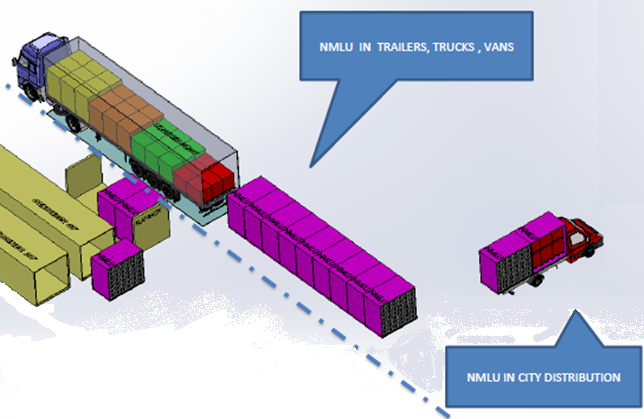Warehousing, intermodality, city and airport distribution
NMLU applied to the living lab
New Modal Load Units (NMLU) results will be tested and validated in this Living lab. This one acts at Cluster level to evaluate the NMLU together with innovative handling and transhipment technology in a real business context to accelerate handling processes within clusters for road and intermodal modes.
The Living Lab determines the scenarios and the desired business logistics: what can or will be changed in order to make the transports more flexible without incurring in major changes in the current infrastructure. To put this into perspective: current load units are 20, 40 or 45 ft in size; the NMLU will have a dimension related to at least the size of 2 euro-pallets or industrial pallets.
The main goals of the living lab
The ambition of this Living Lab is to prove the use of NMLUs in the supply chain efficiency based on standard fixed-size flexible load units capable of supporting modal shift and micro hub distribution.

NMLU basics
NMLU prototypes will be designed and developed, as well as the handling technology. It is an objective to develop modular load unit container prototypes which must fill optimally a 13,6 trailer and a row of modular load units must also fit to the 20, 40 or 45 feet container dimensions, which will be authorized and homologated to be used for both road and rail transportation. Once developed and homologated, these modular intermodal container prototypes will be tested in real business environments. The test consists of:
- loading modular intermodal container prototypes within a live warehousing environment,
- shipping the modular intermodal container prototype from the warehouse to an intermodal terminal,
- transferring the modular intermodal container prototype to a train using the Innovatrain terminal concept,
- transporting the modular intermodal container prototype by rail,
- transferring the modular intermodal container prototype back from the train to the truck.

NMLU Living Lab
Four different scenarios
Living Lab is executed in four different scenarios of logistics businesses in order to prove the efficiency of the new modular load units:
- Warehousing
The part will be executed at the P&G warehouse of Crailsheim (DE) for modular intermodal container prototype loading, the Innovatrain terminal in Oesingen (CH) for modular intermodal container prototype transfer and the road leg between Crailsheim and Oesingen.
- Intermodal transportation (truck and train)
Intermodal truck and train transport have been tested in Venlo by JDR. This is also a cross dock location where LTL freight is being combined into FCL freight. From this location daily truck transport to the rail terminal in Venlo are being carried out. From the rail terminal Venlo TX Logistik operates and controls the train to Milano. Innovatrain also tested the modal transfer from truck to train and backwards.
3. City distribution
Truck with bundled NMLUs can be used both to carry out transportation and to load and unload. These functions were tested as an independent ‘micro hub’ incorporated in activities of urban distribution.
4. Airport distribution
Additionally, the LL will be executed in Brussels airport terminal, where WFS and DHL can ship NMLU units to CityDepot for city distribution testing.
Summarising, it is executed in: a warehouse environment, during transport with modal shift, during urban distributions using the micro hub process and demonstrating the use in cross dock locations. It covers several areas in the Benelux, transports by train from the Netherlands, through Germany and Austria into Italy and will cope with the specifics of city distribution out of Brussels Airport towards inner city of Antwerp, Belgium.


